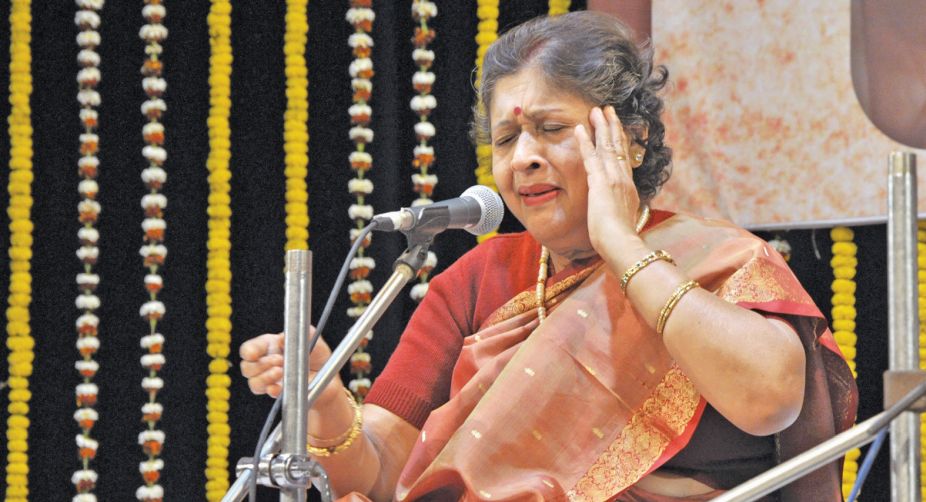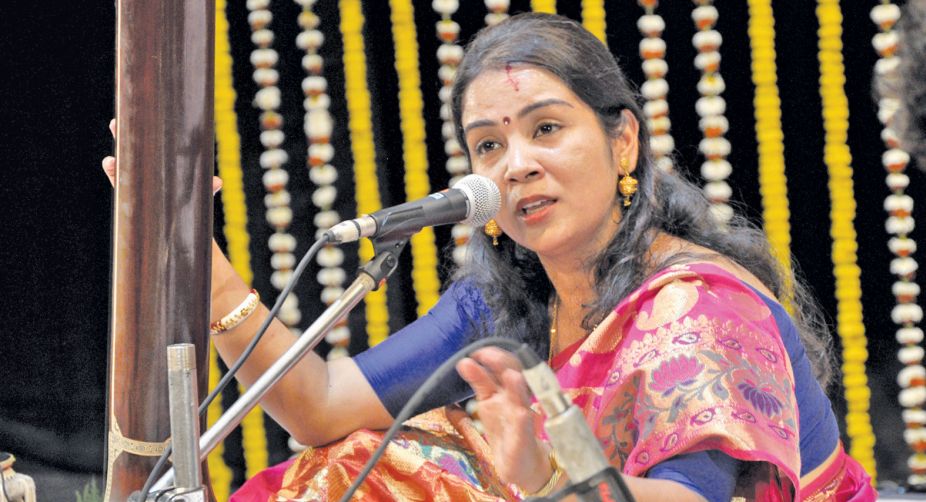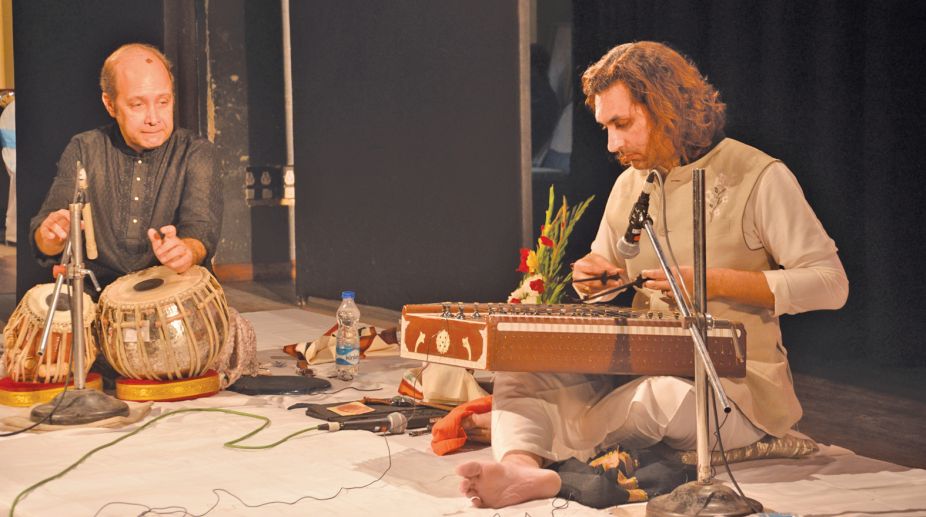Dhwani Academy organised a two-day soiree in memory of Pandits Jnan Prakash Ghosh and Manik Pal, the gurus of tabla maestro Abhijit Banerjee under whose guidance the academy ventures to honour senior musicians and serve the cause of music along with a noble social service dedicated to visually challenged talents.
They are taught and awarded scholarships. With a percussion ensemble by these students, the academy inaugurated the Behala Ucchanga Sangeet Sammelan at Sarat Sadan (Behala) recently.
That was followed by another tabla ensemble of the junior students of the academy. Three brilliant students of Banerjee presented a tabla-trio, packed with thrilling solo rounds, during the evening’s procedure that featured eminent vocalist Ashwini Bhide as the final artiste.
Advertisement
She sang raga Bihag with finely nuanced details that took emotions in its folds all the way. She followed it up with Rageshri and concluded with a bhajan.

Well, known accompanying artistes Sanjay Adhikary (tabla) and Rupashree Bhattacharya (harmonium) added to the beauty of her music with their perceptivity.
Earlier, the Manik Pal Award was offered to Ustad Sabir Khan for his dedicated service to music, especially tabla. Promising young sitarist Snehesh Nag’s delineation of raga Bhimpalasi (with Uchhal Banerjee’s tabla) was imaginative.
Vocalist Shantanu Bhattacharya (ragas Poorvi, Basant Bahar and a Bangla song) selected beautiful compositions of his dadaguru (Jnanbabu) for his inspired recital, well assisted by Sudhir Ghorai’s tabla and Rupashree’s harmonium.
The elaborate alap-jod by renowned sarod exponent Partho Sarothy captured the spirit of raga Shree. Ashoke Mukherjee’s broad-faced tabla was very effective during jod but he could do better by opting for a high-pitched tabla for the gatkari, replete with interesting chhand and powerful bokaris.
The next morning of “Saaz aur Awaaz” was solely dedicated to percussion and its final segment, around noon, included a santoor recital. Many consider this as a percussion instrument that can create melody as well.
Rahul Sharma played raga Bhupal Todi with elaborate alap in the badhat style of his legendary father Pandit Shivkumar Sharma. With Abhijit Banerjee’s seasoned tabla, he displayed great confidence and maturity while handling the complex patterns and phrases in rhythm play-infused gatkari.
However, the day started with Maniuri Pung Cholam and Dhol Cholam including pung, duff, madal, kartal et al. This vigorous and thrillingly well synchronised presentation set the mood for another energetic percussion ensemble by Dhwani’s students, who regularly play in different Bangla bands.
Essentially based on pakhawaj, tabla, khol, khanjira and a Latin American percussion instrument Kajon, it was composed by Abhijit Banerjee based on the concept of Rhythm Parade of Jnan babu.
Glowing tributes
Sangeet Ashram dedicated an evening of enchanting thumris to the late thumri queen (Padma Vibhushan) Girija Devi, who took the Purab Anga Gayaki to its zenith. The event featured four renowned exponents at Birla Sabhagar, led by Vidushi Dalia Rahut, senior gandabandh disciple of Appa ji.
Opening with a seasonal Kafi thumri (Preet kiye chala jaye, medium jat) and a perky Hari dadra (Gara Khamaj, Udat abir gulal), she excelled in Deewana kiye Shyam, a favourite of her Guruma.

Supported by seasoned accompanists Sujit Saha (tabla) and Debaprasad Dey, this soulful rendition was infused with lots of emotions albeit the shaer demanded better enunciation.
In this respect Rajashree Pathak, disciple of Vidushi Shobha Gurtu and Sarala Bhide, impressed with her crystal clear diction and bold, mellifluous voice while singing a Mand Hori (Akhiyan daaro ji gulaal) set to medium-paced deepchandi and steeped in eroticism; very different from Appa ji’s aesthetics who always steered clear of certain lyrics and resultant mood as she believed in nothing but the devotional aspect of love.
Pathak went on to sing a rare dadra handed down to her by Sarala Bhide who had a treasure of old compositions. This was followed by another dadra made famous by Shobha Gurtu.
Finally, she sang a hindola, learnt from Appa ji during her workshop. Ashoke Mukherjee’s tabla and Jyoti Goho’s harmonium offered sensitive support and crafted thrilling laggis.
The short verbal homage by Sucheta Ganguly, who sings khayal and honed her thumri-skills under Appa ji, revealed her nostalgic mood and it seeped through her soulful melodic tributes to her loving Guruma.
Her melodious voice brought the intrinsic agonising pain of Hamse najariya kahe feri(addha), painted the Kafi thumri in emotional colours, displayed yearning of a desolate soul in Chaiti (Chadhat chaita chit laage na) and poured love in Shyam tohe najariya lag jaayegi.

The emotional content was showcased by her superb command on melody and rhythm and their innovative application; especially during talfirta and several laggis — brilliantly played by Sandip Ghosh. Jyotirmay Banerjee’s harmonium was “tongue-tied” in the beginning but opened up with the lighter mood of dadras.
Renowned vocalist Devashish Dey (disciple of Pandit Pashupati Nath Mishra of Banaras) chose to sing two bandhishi thumris, Hato jawo re na bolo Kanha and Nahi bolu tum san preetam, set to ektal and teental respectively, replete with dramatic bol-banav using lots of kaku and thrilling kaat-chhant while applying bol-baant, based on rhythmic designs, perceptively supported by Biplab Bhattacharya’s vociferous tabla.
Hiranmay Mitra’s harmonium remained sensitively quiet while the two were engaged in dialogues. Dey also sang an enjoyable hori set to medium deepchandi. Evidently his style is very different from that of Appa ji albeit both belong to the Banaras gharana.
Advertisement











